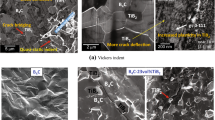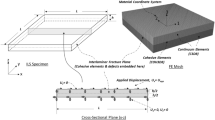Abstract
A micromechanical model that provides explicit accounts for arbitrary microstructures and arbitrary fracture patterns is developed and used. The approach uses both a constitutive law for the bulk solid constituents and a constitutive law for fracture surfaces. The model is based on a cohesive surface formulation of Xu and Needleman and represents a phenomenological characterization for atomic forces on potential crack/microcrack surfaces. This framework of analysis does not require the use of continuum fracture criteria which assume, for example, the existence of K-fields. Numerical analyses carried out concern failure in the forms of crack propagation and microcrack formation. Actual microstructures of brittle alumina/titanium diboride (Al2O3/TiB2) composites are used. The results demonstrate the effects of microstructure and material inhomogeneities on the selection of failure modes in this material system. For example, the strength of interfaces between the phases is found to significantly influence the failure characteristics. When weak interfacial strength exists, interfacial debonding and microcrack initiation and growth are the principal mode of failure. When strong interfacial strength is derived from material processing, advancement of a dominant crack and crack branching are observed.
Similar content being viewed by others
References
Ahrens, T.J. and Rubin, A.M. (1983). Impact-induced tensional failure in rock. Journal of Geophysics Research 98, 1185–1203.
Barrenblatt, G.I. (1962). The mathematical theory of equilibrium of cracks in brittle fracture. Advanced Applied Mechanics 7, 55–192.
Batra, R.C. (1998). Linear constitutive relations in isotropic finite elasticity. Journal of Elasticity 52(1), 75–90.
Belytschko, T., Chiapetta, R.L. and Bartel, H.D. (1976). Efficient large scale non-linear transient analysis by finite elements. International Journal of Numerical Methods in Engineering 10, 579–596.
Brockenbrough, J.R., Suresh, S. and Duffy, J. (1988). An analysis of dynamic fracture in microcracking solids. Philosophical Magazine A 58, 619–634.
Camcho, G.T and Ortiz, M. (1996). Computational modeling of impact damage in brittle materials. International Journal of Solids and Structures 33(20-22), 2899–2983.
Curran, D.R., Seaman, L., Cooper, T. and Shockey, D.A. (1993). Micromechanical model for continuum and granular flow of brittle materials under high strain rate application to penetration of ceramic targets. International Journal of Impact Engineering 13, 53–58.
Curran, D.R., Seaman, L. and Shockey, D.A. (1987). Dynamic failure of solids. Physics, Reports 147, 253–388.
Curtin, W. (1991). Theory of mechanical properties of ceramic-matrix composites. Journal of the American Ceramic Society 74, 2837–2845.
Dugdale, D.S. (1960). Yielding of steel sheets containing slits. Journal of Mechanics and Physics of Solids 8, 100–104.
Espinosa, H.D., Raiser, G., Clifton, R.J. and Ortiz, M. (1992). Experimental observation and numerical modeling of inelasticity in dynamic loaded ceramics. Journal of Hard Materials 3, 285–313.
Espinosa, H.D. and Brar, N.S. (1995). Dynamic failure mechanisms of ceramic bars: Experiments and numerical simulations. Journal of Mechanics and Physics of Solids 43, 1615–1638.
Evans, A.G. (1991). The mechanical properties of reinforced ceramic, metal and intermetallic matrix composites. Materials Science and Engineering A 143, 63–76.
Gao, H.J. and Klein, P. (1997). Numerical simulation of crack growth in an isotropic solid with randomized cohesive bonds. Journal of Mechanics and Physics of Solids(to appear).
Grady, D.E. and Kipp, M.E. (1979). The micromechanics of impact fracture of rock. International Journal of Rock Mechanics 16, 293–302.
Johnson, G.R. and Holmquist, T.J. (1992). A computational constitutive model for brittle materials subjected to large strains, high rates, and high pressure. Shock Wave and High Strain Rate Phenomena in Materials(Edited by Meyers, M.A., Murr, L.E. and Staudhammer, K.P.), 1075–1081.
Jones, D.W. (1996). Ceramic biomaterials. Key Engineering Materials 122-124, 345–384.
Kishi, T., Takeda, N. and Kim, B.N. (1990). Dynamic fracture toughness and microstructural fracture mechanisms in ceramics. Ceramic Engineering of Science Process 11(7-8), 650–664.
Kishi, T. (1991). Dynamic fracture toughness in ceramic and ceramics matrix composites. Engineering Fracture Mechanics 40, 785–790.
Kobayashi, A.S. (1991). Dynamic fracture of ceramics and ceramic composites. Materials Science and Engineering A 143, 111–117.
Komanduri, R. (1989). Advanced ceramic tool materials for machining. International Journal of Refraction Hardening Metals 8, 125–132.
Krieg, R.D. and Key, S.W. (1973). Transient shell response by numerical time integration. International Journal of Numerical Methods in Engineering 7, 273–286.
Lange, F.F. (1979). Fracture toughness of Si3N4as function of initial a-phase content. Journal of the American Ceramic Society 62, 428.
Lankford, J. (1989). Dynamic compressive fracture in fiber-reinforced ceramic matrix composites. Material Science and Engineering A: Structural Materials: Properties, Microstructure and Processing A 107, 261–268.
Lankford, J. (1994). Effect of hydrostatic pressure and loading rate on compressive failure of fiber-reinforced ceramic-matrix composites. Composite Science Technology 51, 537–543.
Lehman, R.L. (1989). Ceramic matrix fiber composites. Treatise Material Science Technology 29, 229–191.
Logan, K.V. (1996). Composite Ceramics, Final Technical Report. USSTACOM DAAEO7-95-C-R040.
Longy, F. and Cagnoux, J. (1989). Plasticity and microcracking in shock-loaded alumina. Journal of the American Ceramic Society 72, 971–979.
Matsui, M. and Masuda, M. (1994). Fracture behavior of silicon nitride at elevated temperatures. Tailoring of Mechanical Properties of Si 3 N 4 Ceramic(Edited by M.J. Hoffmann and G. Petzow), Kluwer Academic Publishers, Dordrecht, Netherlands, 403–414.
Messer, P.F. (1991). The strength of dental ceramics. Journal of Density 18, 227–235.
Niihara, K. and Nakahira, A. (1990). Particulate strengthened oxide nanocomposites. Advanced Structural Inorganic Composites(Edited by P. Vincenzini), Elsevier publishers, 637–664.
Niihara, K. (1991). New design concepts of structural ceramics-ceramic nanocomposites, the centennial issue of the ceramic society of Japan. Journal of Ceramic Society of Japan 99(10), 974–982.
Niihara, K., Nakahira, A. and Sekino, T. (1993). New nanocomposite structural ceramics. Material Reserves Society of Symplectic Procedures 286, 405–412.
Ortiz, M. (1996). Computational micromechanics. Computational Mechanics 18, 321–338.
Rajendran, A.M. (1994). Modeling the impact behavior of AD85, ceramic under multiaxial loading. International Journal of Impact Engineering 15, 749–768.
Ravichandran, G. and Subhash, G. (1995). A micromechanical model for high strain rate behavior of ceramics. International Journal of Solids and Structures 32, 2627–2646.
Seaman, L., Curran, D.R. and Murri, W.J. (1985). A continuum model for dynamic tensile microstructure and fragmentation. Journal of Applied Mechanics, 52, 593–600.
Shockey, D.A., Curran, D.R., Seaman, L., Rosenberg, J.T. and Peterson, S.F. (1974). Fragmentation of rock under dynamic loads. International Journal of Rock Mechanics 11, 303–317.
Shockey, D.A., Machand, A.H., Skaggs, S.R., Cort, G.E., Burkett, M.W. and Parker, R. (1990). Failure phenomenology of confined ceramic targets and impact rods. International Journal of Impact Engineering 9, 263–275.
Shockey, D.A., Seaman, L. and Curran, D.R. (1985). The micro-statistical fracture mechanics approach to dynamic fracture problems. International Journal of Fracture 27, 145–157.
Suresh, S., Nakamura, T., Yeshurun, Y. Yang, K. H. and Duffy, J. (1990). Tensile fracture toughness of ceramic materials: Effects of dynamic loading and elevated temperatures. Journal of the American Ceramic Society 73, 2457–2466.
Vekinis, G., Ashby, M.F., Shercliff, H. and Beaumont, P.W. (1993). The micromechanisms of fracture of alumina and ceramic-based fiber composite: Modelling the failure processes. Composites Science and Technology 48, 325–330.
Walter, J. (1992). Material Modeling for Terminal Ballistic Simulation, Tech. Report, US Army Research Lab., Maryland.
Willmann, G. (1996a). Development in medical-grade alumina during the past two decades. Journal of Material Processing Technology 56, 168–176.
Willmann, G. (1996b). Clinical failure of alumina. Journal of Arthroplasty 10, 855–859.
Woodward, R.L., Gooch, W.A., O'Donnell, R.G., Oerciballi, W.J., Baxter, B.J. and Oattie, S.D. (1994). A study of fragmentation in the ballistic impact of ceramics. International Journal of Impact Engineering 15, 605–618.
Xu, X.-P. and Needleman, A. (1994). Numerical simulations of fast crack growth in brittle solids. Journal of Mechanics and Physics of Solids 42, 1397–1434.
Xu, X.-P., Needleman, A. and Abraham, F.F. (1997). Effect of inhomogeneities on dynamic crack growth in an elastic solid. Modeling and Simulation Material's Science and Engineering 5, 489–516.
Yang, Kwan-Ho, Kobayashi, A.S. (1990). Dynamic fracture response of alumina and two ceramic composites. Journal of the American Ceramic Society 73(8), 2309–2315.
Zeng, J., Tanaka, I., Miyamoto, Y., Yamada, O. and Niihara, K. (1992). Sintering behaviors of Si3N4-silica ceramics during hot isostatic pressing. Journal of the American Ceramic Society 75(1), 148–152.
Zhai, J. and Zhou, M. (1998). Micromechanical modeling of dynamic crack growth in ceramic composites. Mixed Mode Crack Behavior(Edited by K. Miller and D.L. McDowell), ASTM STP 1359, 174–202.
Zhao, J., Stearns, L.C., Harmer, M.P., Chan, H.M. and Miller, G.A. (1993).Mechanical behavior of alumina-silicon carbide nanocomposites. Journal of the American Ceramic Society 76(2), 503–510.
Zhou, S.J. and Curtin, W.A. (1995). Failure of fiber composites: A lattice green function model. Acta Metallurgica et Materialia 43, 3093–3104.
Author information
Authors and Affiliations
Rights and permissions
About this article
Cite this article
Zhai, J., Zhou, M. Finite element analysis of micromechanical failure modes in a heterogeneous ceramic material system. International Journal of Fracture 101, 161–180 (2000). https://doi.org/10.1023/A:1007545105723
Issue Date:
DOI: https://doi.org/10.1023/A:1007545105723




